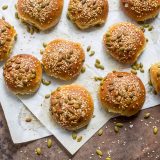
Walk down the aisles of any American supermarket until a few years ago and the flour section was predictable and basic: all-purpose, cake, self-rising, whole wheat and, perhaps, bread flour.
In Europe bakers have dozens of choices, as well as entirely different ways of thinking about it. Flour is graded based on the fineness of the milling (as in “00” flour from Italy), or on the amount of ash residue in 100 grams of flour after incinerating it at 900°C. (The higher the number, the more whole grain the flour. So a dark rye would rate over 1,300; a light rye around 1,100.)
And all sorts of grains are pressed into service. At my favorite breakfast spot in Salzburg, 220 Grad, they offer a millet porridge, millet being nothing new to Austrians. In Germany, pumpkin seed bread—Kürbiskernbrötchen—is made with pumpkin seed flour, an ingredient you are unlikely to find stateside. They also throw in rye flour, flaxseed, whole-wheat flour, steel-cut oats and sunflower seeds.
Other than ingredients, we also had the issue of texture. Germans and Austrians love dense, dark loaves. My wife, whose mother is from Salzburg, has given me an earful about “Schwarzbrot” (black bread); those squat, dense loaves are no stranger to our table. But this is an acquired taste and so, for our recipe, we opted to transform German/Austrian pumpkin seed bread into a lighter, less rustic holiday roll while keeping its essential flavor profile.
Most traditional recipes call for an overnight sponge, but this did little to add flavor to these rolls. After all, they are packed with flavorful ingredients. And so a quicker yeast dough was in order. We made a sponge with rye flour, warm water, honey and yeast which sat for just an hour before preparing and kneading the final dough. This sponge is particularly effective with rye flour, which absorbs eight times its weight in water; regular wheat flour absorbs only twice its weight. This produces a particularly soft, moist final roll, an outcome that is boosted by the use of 4 tablespoons of butter; the fat coats the proteins in the flour, which weakens the gluten and produces a softer texture. After an hour, the sponge is kneaded with the other ingredients into a dough, allowed to rise for an hour, then cut and shaped into rolls, which then proof a second time for a half hour.
For ingredients, we chose rye and bread flours. (Rye is a signature, essential ingredient.) For nuts, the recipe required pumpkin seeds (also called pepitas), but we also threw in sesame seeds since they are widely available.
The next question was what to do with the nuts. Many recipes suggested chopping and soaking them overnight, but we found this did nothing to improve the texture of the final rolls. We agreed with most traditional recipes that toasting the seeds added flavor (we did this in a skillet), but then we processed the nuts with softened butter in a food processor to create a nut butter that was then added to the sponge before kneading.
Buttermilk, a common ingredient, muted the flavor of the seeds, made the crust too soft, and produced a gummy final texture. Oil versus butter gave us less flavor and a less crisp crust, though we found that the butter was best used softened, rather than melted, for a less greasy result.
Many recipes call for cutting the dough into squares without shaping into balls, but we found that the shaping provides a better rise. And this is the key to this recipe. A gentle hand while shaping the dough to form a taught, smooth surface is essential to get the light, airy texture we were hoping for. An egg wash and a sprinkle of toasted pumpkin seeds on top dressed up our rolls that were now aromatic and nutty, but also tender, the way that we like them at the holidays. A pinch of large grain sea salt on top just before the second rise also perked up the recipe with small hits of flavor.
Unlike the buttery soft, white tablecloth parkerhouse rolls that have graced my holiday table for years, these pumpkin seed rolls offer both rustic flavor and better texture. They stand up nicely to a smear of butter and a cup of coffee for breakfast and keep nicely for days.




